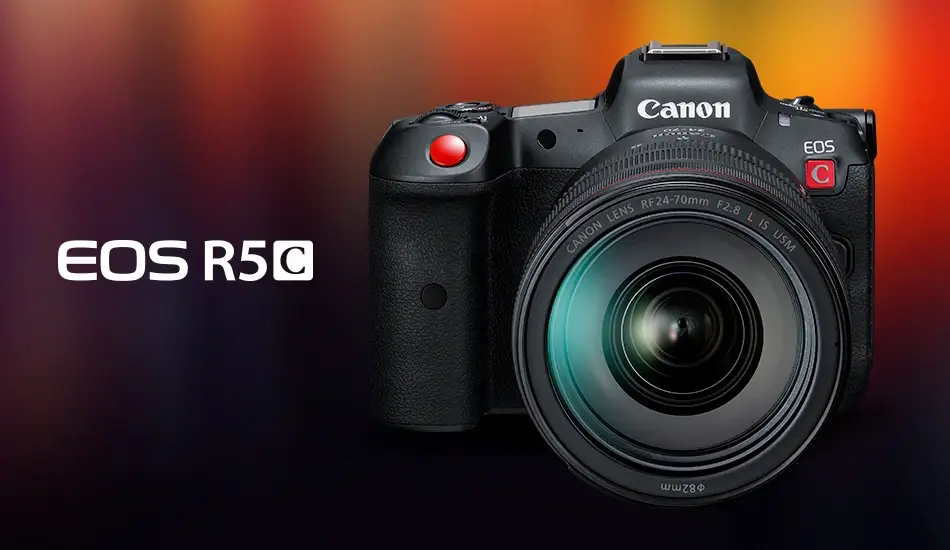Canon announces the R5 C Mirrorless Cinema Camera
Larger body with active cooling, 8K60 RAW Light
4:32 read

click to enlarge
The long rumored Canon R5 C has finally been announced. At first glance it looks very much like the original R5 hybrid camera, but when you spin it around to the back it becomes obvious that some physical changes have been made. Most notable is the addition of a cooling fan behind the flip-out screen. This is a direct action to mitigate overheating issues. The R5 C can now record 8K60 non-stop. This means the artificial 30 minute record limit has been removed. It also adds a timecode connector and hot shoe support for XLR adapters. This places the R5 C somewhere between the R5 and C70.
For reference, I've been shooting video with the Canon R5 for nearly a year and I've become very familiar with it's features and limitations. It's not the best video camera out there, but it's better than a lot of cameras and the raw is stellar.
What's New
The R5 C notably has a cooling fan placed between the sensor and the flip-out screen. Overheating was an issue with the R5 and it had an artificial 30 minute record limit. This meant you had to manually trigger recording every 30 minutes and have a gap in your footage. That's no more. Hopefully Canon will retire this silly limit across their entire lineup.
- The R5 C can now record up to 8K60 in raw light.
- It has timecode I/O.
- Super 35 and Super 16 modes in raw.
- The menus for video are the same as on the other cine cameras.
- It has professional monitoring tools like waveforms, vectorscopes, and false color.
- It supports XLR audio adapters like this one from Tascam.
- There's a tally lamp on the front.
- Audio is now recorded in 4K120, albeit in a separate file.
The R5 C has cinema raw light instead of just raw light. This is the same light codec that's in some of the other Canon cine cameras. Whether it is really any different from "raw light" remains to be seen.
It can record in HDR, both PQ and HLG. The R5 already had a Rec.2020 gamma option so again, who knows what difference there is here.
What's the Same?
The R5 C still has a 45.0 megapixel sensor and it's likely the same as in the R5. This means the still photo specifications should be exactly the same. ISO range, frames per second, and burst speeds are all the same. The viewfinder still has 5.76 million dots of resolution and the screen is still 3.2-inch 2.1 million dots.
It uses the same batteries: LP-E6NH/LP-E6N/LP-E6.
The R5 C still has a micro HDMI output.
What's Missing
Canon has removed IBIS (in-body image stabilization) from the R5 C. This means the sensor is no longer stabilized although lens stabilization is still available. This is both good and bad. Stabilized sensors can actually create problems in certain filming situations. Even with IBIS turned off the sensor is never fully locked to the camera. It's always held by electromagnetic supports. It's possible for the sensor to move when the camera is shaken or vibrated, such as when mounted on a car rig. A camera with a non-stabilized sensor won't have this issue, although rolling shutter may still be a problem. This change is very much like what Panasonic did with the GH5 and GH5s (even the red record button).
Instead of IBIS there is now Enhanced Image Stabilization (EIS). This adds a 1.1x crop and is only available on non-raw modes. Lens stabilization still works.
There are no built-in ND filters like on the C70.
There is no CLog2. C'mon Canon . Give us the good stuff.
What's Bad
Micro HDMI 😤. The R5 C should really have a full size HDMI output. The micro HDMI cables are too fragile for professional use.
Switching from video to photo mode takes 8 seconds. Yes, it takes forever. I don't see this being a dual purpose tool field for professional use. If you're just shooting stills you should get the R5. If you're just doing video, the R5 C is fine. If you're doing both, get the R5. It switches between video and photo modes in a split second. I programmed a button on mine to switch between modes and it works great.
It chews through batteries. Kai Wong mentioned in his video review that you get 40 minutes per battery (hello BMPCC). Also, you can't do 8K60 with the internal batteries. You have to use an external power solution 🤨.
The focus system for video is like the C70, which means it's not as good as video auto focus in the R5 .
Should You Buy the R5 C?
The decision about whether the R5 C is the camera for you largely depends on your specific needs. If you need high frame rate 8K video, timecode, or better audio functionality, go for the R5 C. If you record long takes or you're concerned about overheating, again go for the R5 C. Otherwise, the R5 will suit you just fine. The R5 has the same stills capability and much of the same video functionality. It just doesn't have the higher frame rates and fan cooling.
30












Comments